Is Campher Tree Mulch Good For Gardens
Fall is here and so are the leaves. Fall leaves in the yard can be a nuisance—something you have to clean off your yard so the grass doesn't die. Bag 'em up and drag 'em to the curb. What a pain!
At least, I used to think that way.
Amy changed my perspective. She was my big influence.
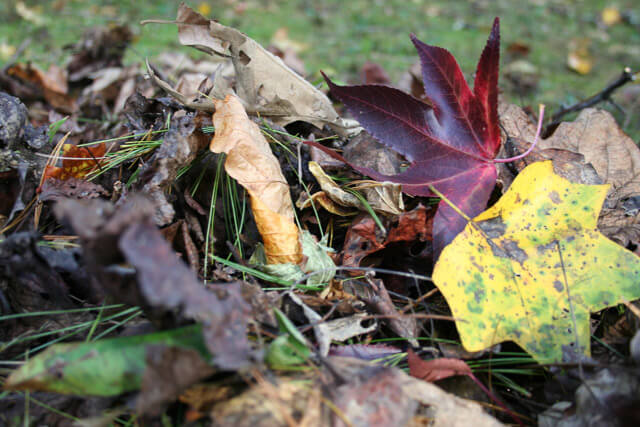
Early on in our romance, we both worked near a big park in Albuquerque. When city workers bagged up the leaves, Amy insisted I drive by on our way home from work. We tossed bags into the truck bed and took them home for the garden.
At the time, I thought she was insane. I probably rolled my eyes a little.
Amy also talked me into building our first compost bin out of old pallets in the backyard. I probably rolled my eyes then, too.
But that was then.
More than ten years later and still learning from Amy, I've developed a passion for persuading others to use their leaves (and other organic material) in a garden, instead of sending them to the landfill.
Did you know?
The EPA estimates over 50% of solid waste in American landfills is organic.
That's right. One half of our trash is paper, food, and yard waste, including bags of beautiful fall leaves.
Not my leaves!
At our place, the leaves are a valuable fall crop we harvest along with the potatoes, squash, and apples.
Our leaves are a gift—dropped at our feet to cycle nutrients, build soil, and blanket our trees and shrubs against winter's cold.
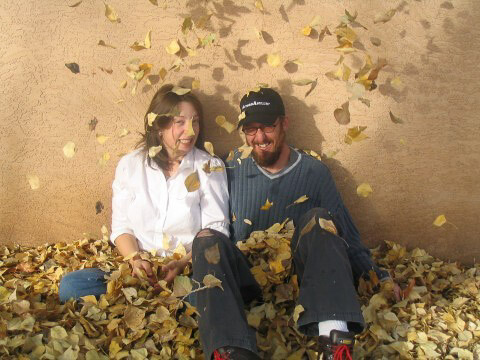
You should know…
Fall is my favorite season of the year.
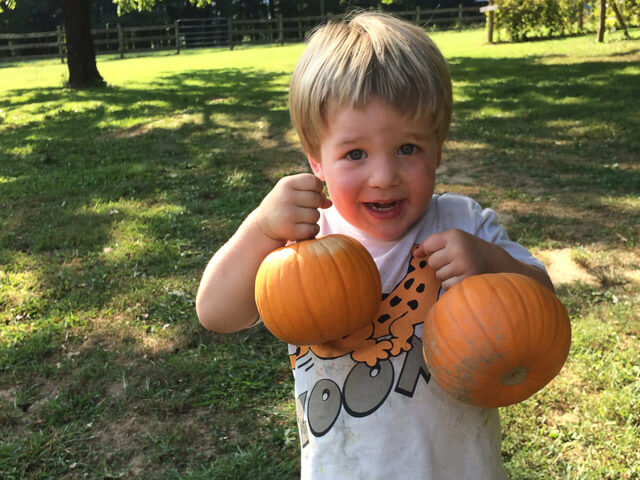
My mind conjures up images of pumpkins and apples, football and flannel shirts, state fairs and haunted houses. And, of course—orange, red, and yellow leaves.
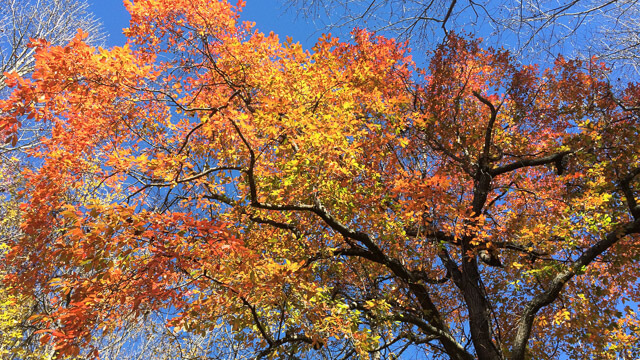
Trees are beautiful to look at as they change. They transform summer's lush green to fiery hues of autumn.
A bit much? Okay, so I am not a poet. But it's hard not to wax poetic in fall.
"Fall has always been my favorite season. The time when everything bursts with its last beauty, as if nature had been saving up all year for the grand finale."
~ Lauren DeStefano
I couldn't have said it better.
Fall leaves are beautiful and useful.
Leaves are a key ingredient in our recipe for garden success.
Happy gardens have abundant organic matter. If you live in a place with deciduous trees, leaves are one of the best and cheapest sources of organic matter you can find.
Here are 8 ways we use our leaves. (And you can, too!)
1. Play in them
Eventually, our leaves will be used for mulch and compost, but before that happens—we play in them.
As I said, leaves are a gift—and gifts are meant to be enjoyed.
When was the last time you played in a big, crunchy pile of leaves?
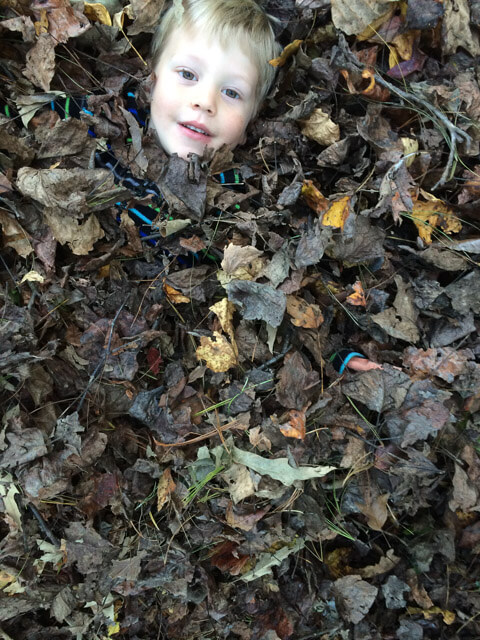
2. Compost them.
Many of our leaves get composted. They are an excellent source of carbon and contain minerals that trees draw from deep in the soil.
When leaves become compost for the garden, our vegetables get access to those nutrients and minerals. (And when we eat the veggies, we do, too!)
We use wire bins to handle the bulk of our composting duties. A pallet bin, tumbler, or a simple pile in the corner of the yard will all work just as well.
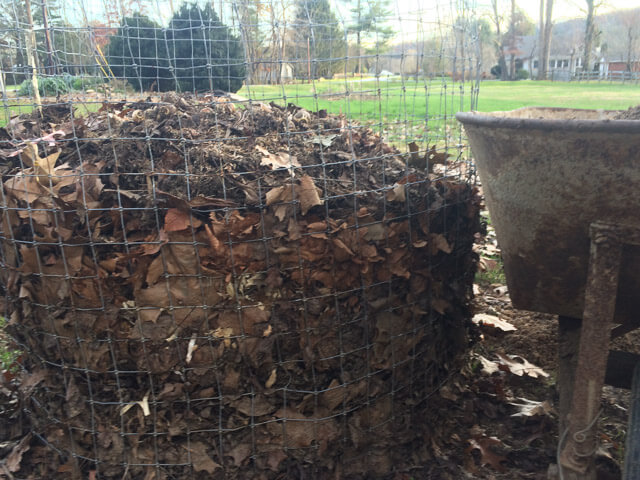
We simply mix the carbon-rich leaves with our nitrogen-rich kitchen scraps, coffee grounds, garden trimmings, and chicken poop and voila!…we have compost.
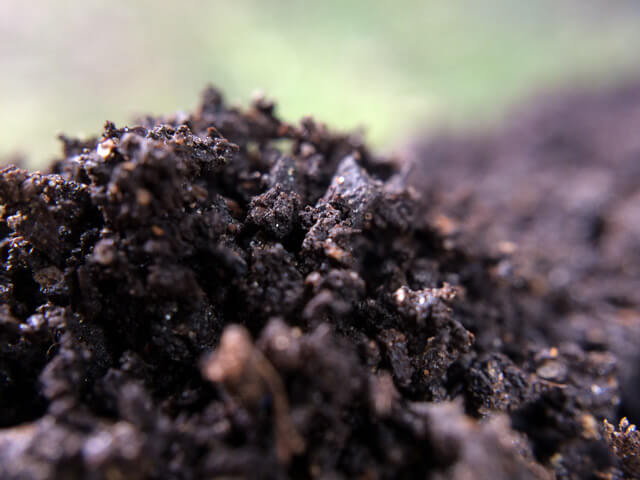
Okay, okay, so that is not all there is to it.
There are pesky little details to consider like the passing of time, carbon:nitrogen ratios, moisture and air levels, pile turning, and the stuff you shouldn't include in your pile. I'm not able to explain all of that in this post. However. . .
If you are new to composting, we have an introductory class called Quick Start to Composting , where Amy walks you through the need-to-know details. If you'd like an invitation when we open the class, be sure you sign up for our email list in the sidebar. —->
You'll discover just how easy it is to get started!
3. Use as Mulch.
Leaves are our go-to mulch. They are abundant and cheap (as in free).
In fall and winter, we use them to mulch under our trees, shrubs, berries, and perennials. We use leaf mulch to blanket empty garden beds, too. It protects and insulates the soil and plants from the cold. Worms and microbes graze on the mulch and continue working through the winter.
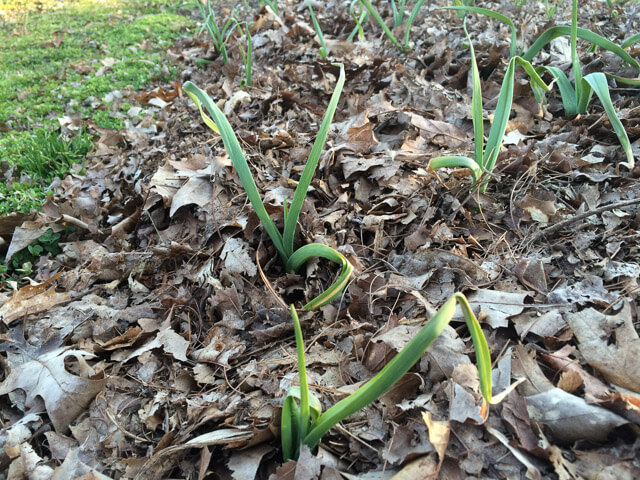
Garlic sprouts work their way through fall leaves used as mulch.
In spring and summer, we use leaf mulch in parts of our annual garden beds and herb spiral. Leaves help the soil retain water, keep weeds in check, and yep, you guessed it—feed the wormies.
We prefer shredded leaves for a few reasons:
- Easy to maneuver around plants
- Break down more easily into the soil
- Less likely to get matted (and cause rain to run off instead of seep in)
- Take up less space, so we can store more! (We can fit ten bags of leaves into onebag once they've been shredded.)
There are cool leaf shredding machines, but since most of us don't have one, the next best option is a lawnmower. Run over them several times to get the maximum shred.
Store your mulch in a wire bin or bags until needed. Be sure to put plastic bags in a garage or barn. Left in the sun, those thin black bags break down into a mess of degraded plastic flakes that you do not want to have mixed in your leaves. (Amy learned this the hard way…)
When you mulch, be sure to keep the mulch away from the stems and trunks of the plants. Allow plenty of room for air circulation. Mounding mulch directly against a plant encourages disease and decay.
4. Sheet mulch.
Use your leaves to smother weeds in a technique called sheet mulching.
We often use this technique when starting a new garden bed.
First, we lay down cardboard or several layers of newspaper where we want to plant, wet it thoroughly, and cover it with several alternating layers of compost (or manure), shredded leaves, and wood chips. Over time, it all decomposes to leave behind rich, fertile, alive soil perfect for planting.
The cardboard layer prevents weeds from growing through. (We've had pretty good luck using sheet mulch to manage bindweed, goatheads, and poison ivy. I imagine it could help knock back gout weed, too. The really pernicious weeds may work their way through along the edges, but hopefully, you'll get a head start!)
Toby Hemenway, who wrote one of my favorite books Gaia's Garden, A Guide to Home-Scale Permaculture, has a Bomb-Proof Sheet Mulch "recipe" that we've tried before with great results. But you'll see soil improve with just a simple version—cardboard and eight inches of leaves.
5. Make leaf mold.
Imagine a walk in the forest. Can you feel the soft, spongy ground under your feet? That's decades of nature's original version of leaf mold.
Leaf mold is compost made using only leaves, and it is so simple. Pile up leaves and come back a year or so later!
| Leaf Mold | Regular Compost |
|
|
Both hot compost and cool leaf mold improve soil structure, increase water retention, and provide a comfortable habitat for worms and microbes when used as mulch.
You can speed up your leaf mold production by shredding the leaves, keeping the pile moist, and turning it occasionally.
6. Make art.
Leaf art projects are a good way to spend an autumn afternoon with your kids.
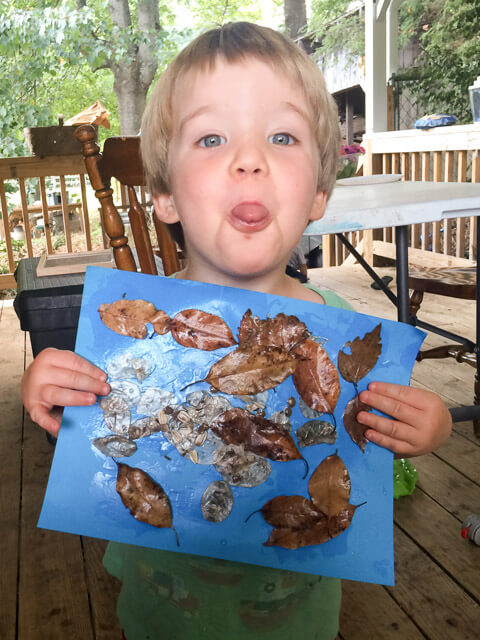
Sure, a few gathered leaves for art projects isn't going to save you from raking leaves, but it's a fun opportunity to enjoy the leaves.
Gathering the leaves to use in projects is a great activity in itself. It gives our boys a chance to learn and explore nature. Amy loves to practice leaf identification with our 4 year old, and our 2 year old joins in with his own innovative pronunciations.
The best time to gather leaves for art projects is right after they have fallen—before they dry out and get crumbly. Freshly fallen leaves have more color and preserve better.
For best results…
- Gather up (freshly fallen) leaves (get more than you think you will need) and place them in between the pages of large books (encyclopedias are good for this). Only use one leaf per page.
- After you have loaded your leaves into the books, set the books on a flat surface, pile another book or two on top, and leave them alone.
- After a week or two, you will have nicely pressed leaves perfect for artsy-crafty stuff.
I am not able to explain all the potential leaf art projects in this post, but to get you started, my favorite is leaf collage.
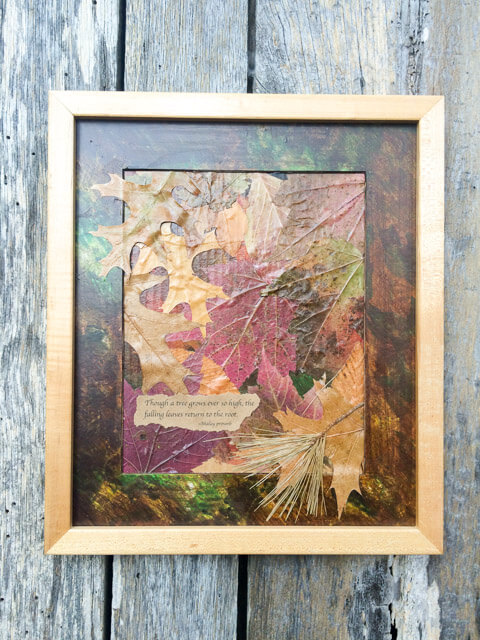
"Though a tree grows ever so high, the falling leaves return to the root." I used this Malay proverb on leaf collages I made for our families one Christmas.
For more advanced craft ideas, check out this post for inspiration.
7. Leave the leaves.
You know, letting leaves stay on your lawn is okay.
In fact, it is good for the lawn. The minerals in leaves are as valuable to the plants and soil in your yard as they are in your garden.
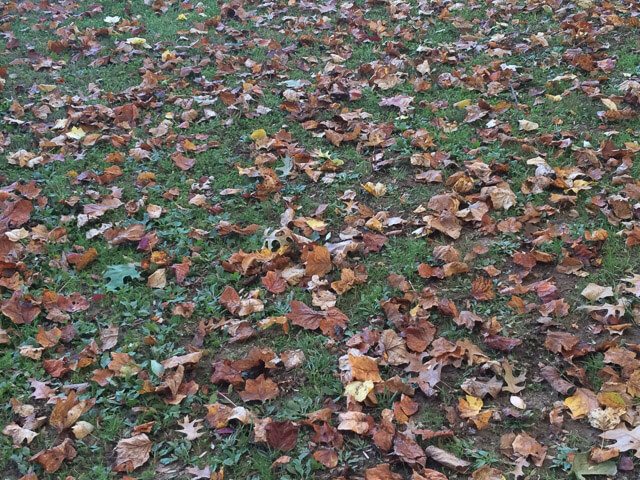
Should you leave them on your lawn as is?
That depends.
If you have loosely scattered leaves on your lawn or the leaves are mostly in non-grassy areas of your yard—then yes. No work required!
If you have lots and lots of leaves that pile up in layers—then no. They can mat up and smother your grass.
Simply, run over them with a lawnmower to shred them into smaller pieces. More surface area for microbes and worms to munch on!
We don't leave many leaves on our lawn, but we do leave them in the pasture, mowing them in with the grass and nitrogen-rich horse poop.
8. Donate them.
If you have any leaves to spare (which seems impossible after #1-7!), don't even consider sending them to a landfill. Some gardener in your life needs your leaves, especially if you don't use synthetic insect and weed killers.
If you are not willing or able to compost or use leaves in your yard or garden, consider these options:
- Give them to a friend, neighbor, or community garden.
- Check with garden centers, nurseries, or local landscapers for takers.
- Post "free leaves" on Craigslist.
- Explore your city or county's programs for yard waste disposal, recycling, and composting.
Many cities and counties have free or low-cost yard waste collection facilities where they do large scale composting. Some even give the compost back to participating residents for free!
A word of caution.
Be careful about composting and mulching with leaves from walnut, eucalyptus, camphor laurel, and other trees that have allelopathic chemicals. These chemicals inhibit seed germination and plant growth. Talk with your local extension agent or nursery to see what species grow where you live.
Once you know which plants you're dealing with, you can look up what other plants are sensitive. If you're mulching or composting around plants that aren't sensitive to the allelopathy, you need not worry.
Trees are awesome!
Now you know 8 ways to use the colorful gifts that fall from above. Leaves enrich our soil and our lives. And that's not the only thing trees give us…
They provide food, shade, wood, wildlife habitat, oxygen, cleaner air, and climbing fun.
Have you hugged a tree today?
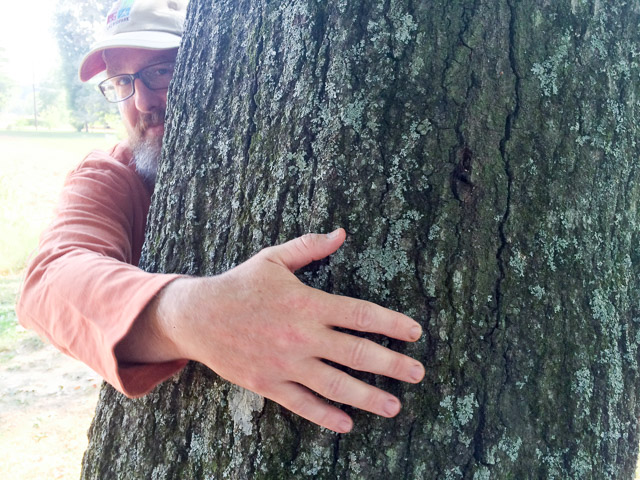
Well, you should. Here are 22 reasons why.
"Time spent amongst trees is never wasted time."
~ Katrina Mayer
How do you feel about leaves?
Do you love the fall season as much as I do? What will you do with your fallen leaves?
Amy and I would love to hear from you in the comments below.
Is Campher Tree Mulch Good For Gardens
Source: https://www.gardensthatmatter.com/a-gift-from-above-8-ways-to-use-fall-leaves/
Posted by: duryeapecter.blogspot.com

0 Response to "Is Campher Tree Mulch Good For Gardens"
Post a Comment